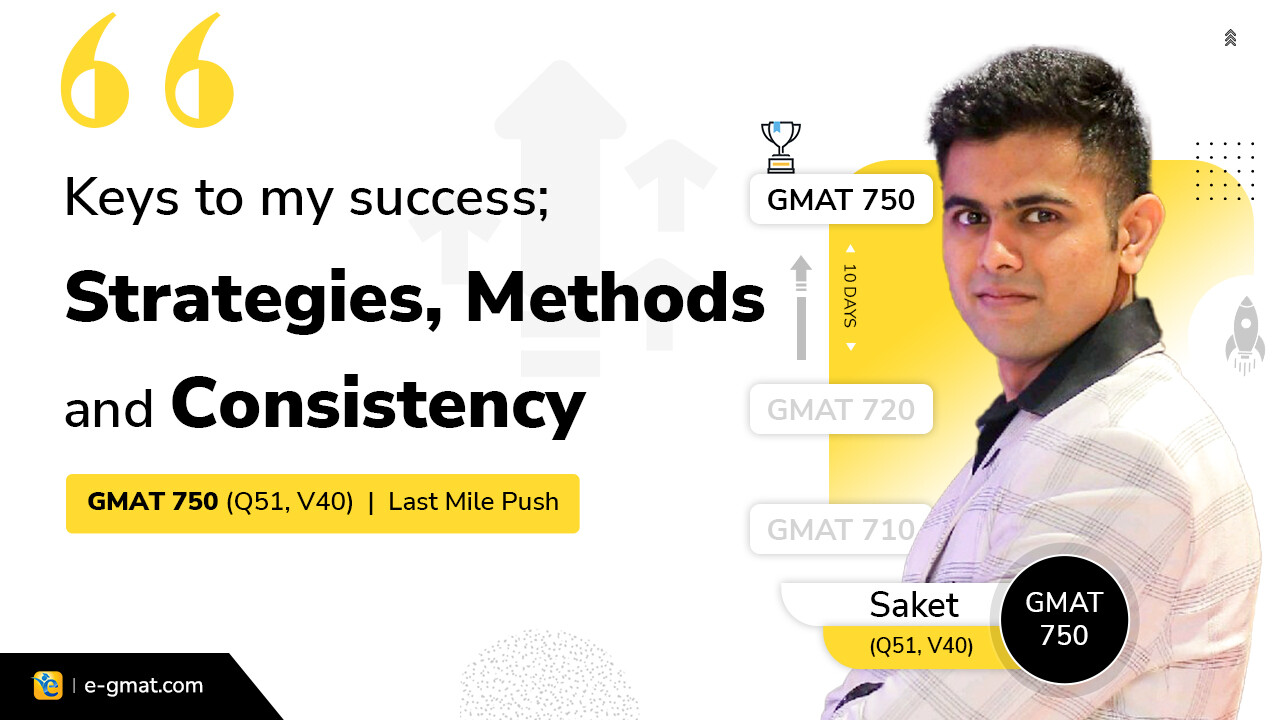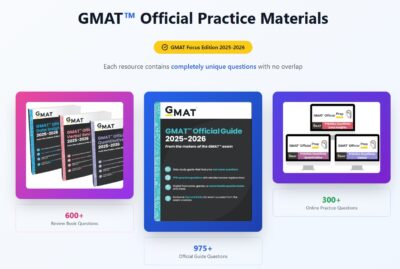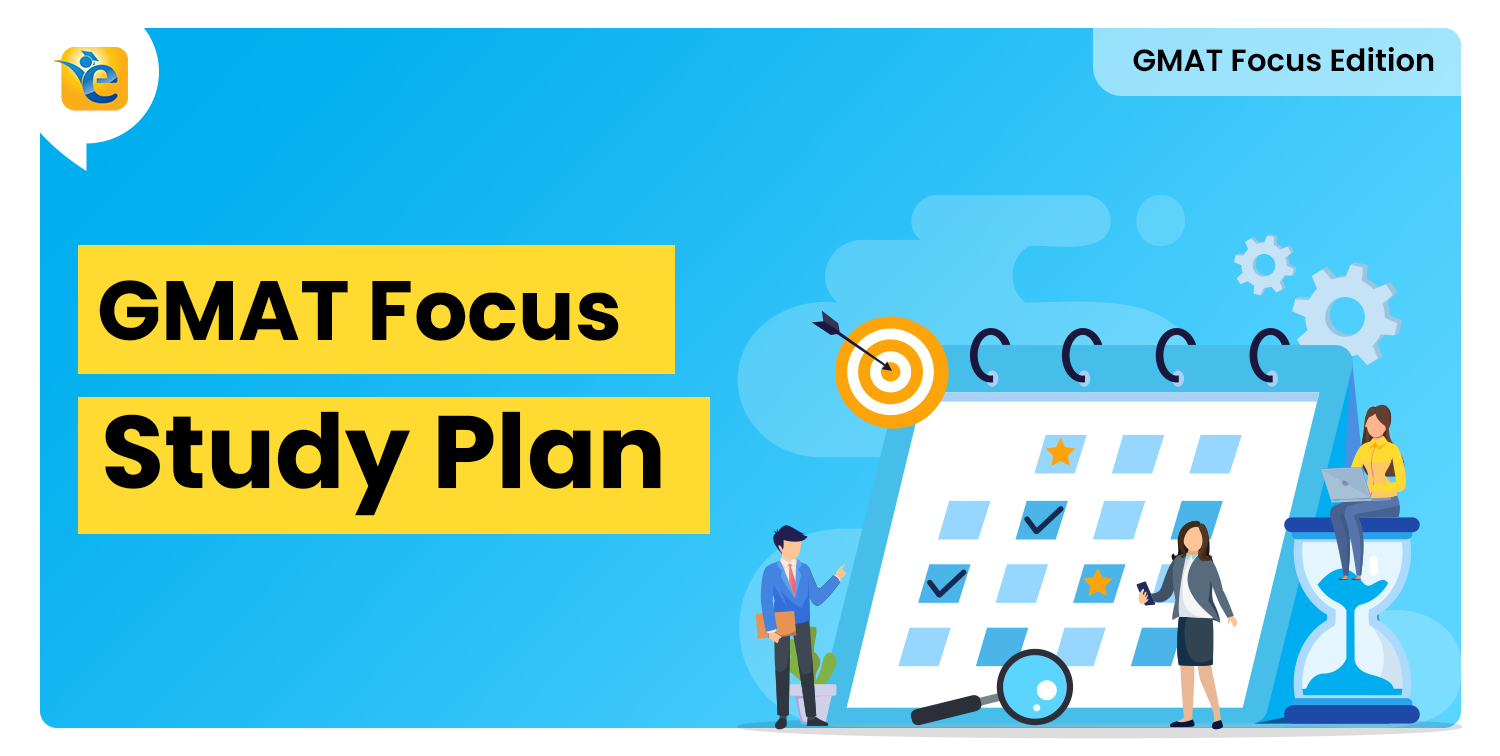GMAT 720 or even 710 demands incredible hard work and commitment. These were Saket’s scores in his first two attempts, both of which he prepared using free resources. As he says, it gets exponentially harder to make every 10-point improvement after 720. Having GMAT 750 as his target score, Saket was determined not to settle for anything less.
During one of the e-GMAT’s free webinars, Saket realized that the methods and strategies taught in the e-GMAT course could help him ace the GMAT.
His diligence, consistency, faith in the course, and the guidance he received from his mentor ultimately brought him much-awaited success.
Watch Saket’s story as he shares his journey from being stuck at 720 for months to scoring 98%ile in 10 days with the support offered in the Last Mile Push program.
Scoring a 750 on the GMAT
Saket: My first e-GMAT mock score was 710. I managed to push it to 740 in my mock before the exam, and in the actual GMAT test, I scored 750.
The e-GMAT is a very versatile tool. I used the course mainly for the verbal. I started with V39 and improved to V41 in my mocks, but in the actual exam, I scored a V40. That proves it’s a very consistent tool to gauge your performance. Also, the feedback I received from you(my mentor) helped me reach my target score, GMAT 750.
I had taken the GMAT once earlier and scored a 720. I had set my target as 750, even a 740 would not have been acceptable to me, and that’s why I was sure I had to give my 100%. I am delighted to have achieved that. Thanks to e-GMAT once again.
Preparation before e-GMAT
Abha: In your last year’s attempt, you scored GMAT 720(Q50 V38). What was your preparation approach then? How did you decide to enroll in the e-GMAT course?
Saket: Last year, while preparing for the GMAT, my approach was limited to Official questions and YouTube webinars. I attended three webinars hosted by e-GMAT. During the session, they explained the meaning-based approach for a couple of SC questions, which helped me understand how to approach those kinds of questions.
As per this method, when you get two grammatically correct answers, you’ve to eliminate one of them based on their intended meaning; that was something I had never seen before.
So, that experience was the key reason I decided to go for the course. Unfortunately, I had attended that webinars 5-6 days before the exam, and I practically had no time to join the course. Hence, I continued with the official mocks and scored a 720.
For verbal, my approach was to solve as many questions as I could. Also, I was practicing on paper. There was no digital tool; hence, it was difficult to maintain any error log. I had it all in my memory only. It was a very non-structured approach to maintaining a verbal guide.

How to make an Error Log?
Abha: How exactly does an error log help? What kind of details were you filling in the error log?
Saket: I maintained three error logs, each for SC, CR, and RC. In the log, I’d include,
- Question links
- Difficulty level of the questions (700-800, 600-700, 500-600)
- Time I took to solve each question
- Type of question (e.g., SC has a modifier question, in CR, there is Strengthen/Weaken question)
- The option choice I made
- Reason I chose that particular answer
- Correct answer choice
- The finding and the rationale given by e-GMAT
This time, I had a detailed and comprehensive error log, which helped me compare my reasoning with the tutor. With this, I was able to understand the tutor’s mind. When I revisited the questions, I chose the answers for the right reason instead of because they sounded or felt good. That detailed, one-level-down approach to the error log was instrumental.
Perhaps this was one of the most critical factors that helped me go from 720 to 750.
I used to solve many questions, but I never maintained any error log earlier. Every time while solving a question, I’d check the answer and move on. I never realized if I had spent one and a half minutes extra reviewing the questions, even if those were presented later with some tweak, I’d have been able to understand and solve them. And that’s possible with the error log I never maintained. It genuinely helped me a lot.
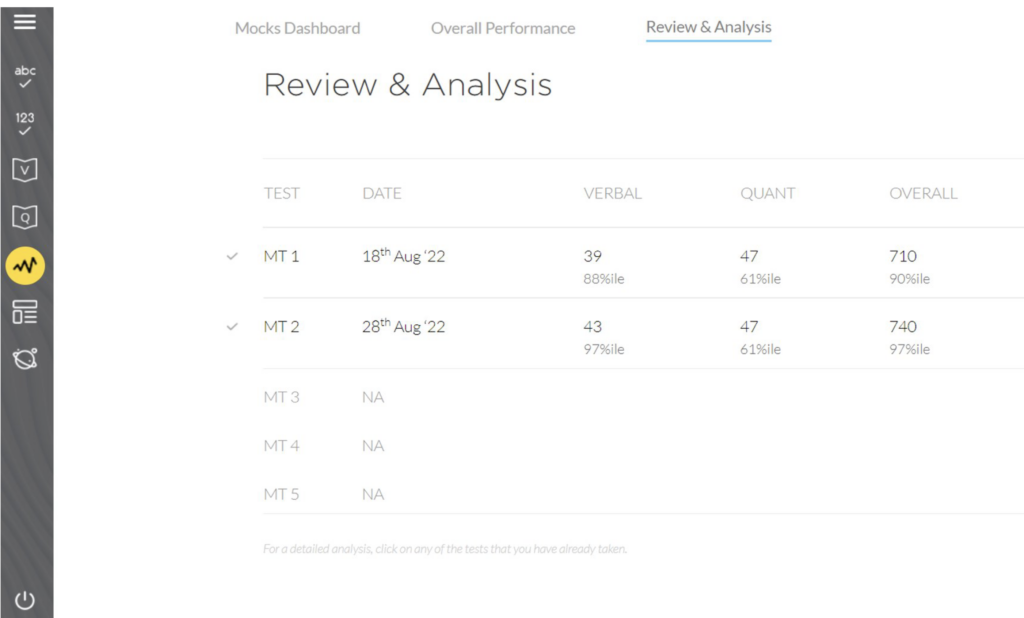
Effective methods for GMAT verbal
Abha: For quant, you were consistently scoring Q50 or Q51. You primarily used the e-GMAT platform for verbal. And you started V38, but we know it takes a lot of effort to go from V38 to V40.
Could you tell us how your approach was different for SC this time?
Saket: On the first day with e-GMAT, I took the SIGma-X mock. I found out where I was faltering. The e-GMAT course offers extensive mock analysis with a detailed section-wise breakdown. I could see the percentage I was at in SC, CR, and RC, which we don’t get in official mocks. For this reason, also I recommend e-GMAT.
I started SC with 81 percentile in my first mock, and then I reattempted the questions I did wrong. So, if I didn’t get a modifier question right for comparison error or parallelism error, I’d revisit the modules of those respective topics. In e-GMAT, there are different modules broken down into topics so, if I am not doing too well in a particular concept, I can go back and refer to those specific topics instead of going through the entire module. I think the modular approach is a very efficient use of time. Once I identified a concept gap, I could quickly glance at it and fix it.
The intended meaning approach was another thing that was very helpful to me. There were questions in my GMAT test also where I applied this method. This approach is about what the author is trying to say versus the meaning you are trying to derive. There are many grammatically correct answers, and you have to choose one based on your judgment of what the author is trying to say. And that’s where the meaning-based approach was handy. This topic is very intense, and I revisited it twice. This method also helped me a lot in SC.
Abha: I am delighted that the meaning-based approach helped and worked out well for you.
What was your strategy for RC? Unlike SC, where we get one question, RC has an entire passage based on which you have multiple questions to answer. How did you approach those questions?
Saket: I completed the entire RC course module because I was a bit dicey at it. I took the top-down approach. After every module I finished, I took the quiz and noted my percentile in that module before moving to the next one. The links provided by the LMP team were handy. Learn Visualisation and Pre-thinking methods to ace CR. Also, the pre-thinking approach focuses on the keywords. That method helped me both in RC and CR.
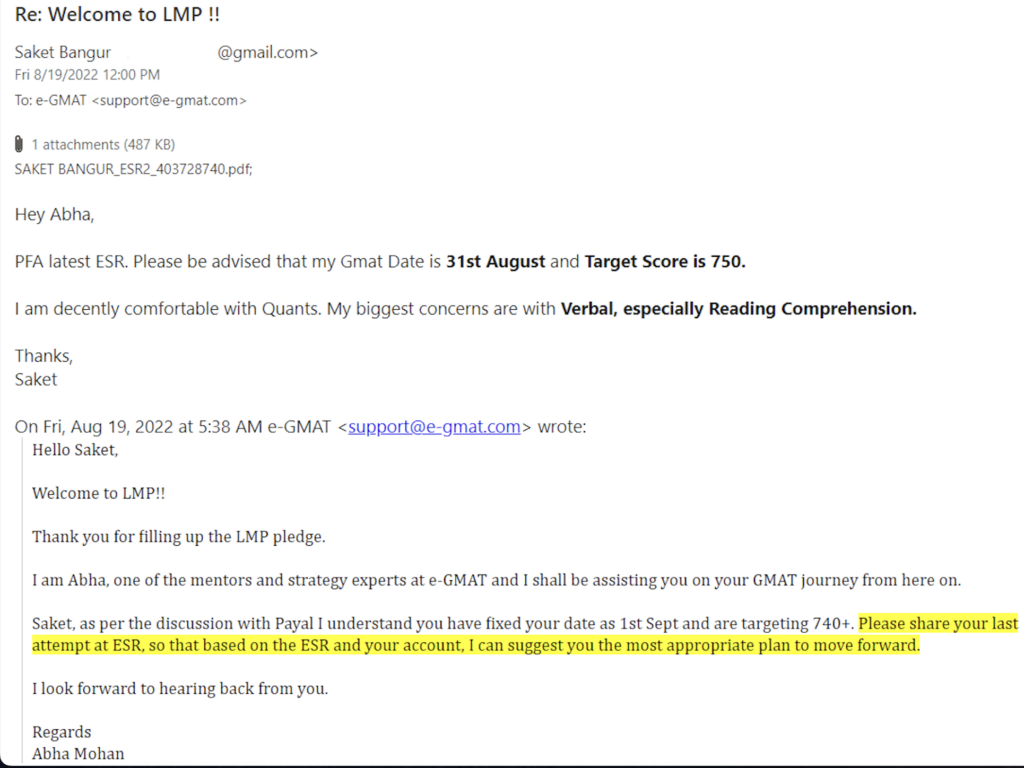
As soon as you get a question with specific keywords, e.g., justly, it indicates that the author already agrees with what’s said earlier. It’s just one small word; if you miss it, you miss the real sense and get the question wrong. Focusing on the keyword has been quite a good strategy for me in RC. Also, initially, I used to skim the passages and finish reading them in two minutes which would confuse me with the answer choices and then bounce back at the passage. It was a flawed approach that took more time and reduced accuracy. Once I started with the e-GMAT approach, it made a lot of sense. There was no skimming anymore. They suggested reading the passage, understanding it, jotting down the summary, and then looking at each paragraph in context to the overall summary. A better understanding of the passage makes a big difference.
A better understanding of the passage makes a big difference.
Strategy to go from 720 to GMAT 750
Abha: Once you finished studying the concepts in all the subsections, how did you prepare for the application of those concepts? What kind of questions were you solving on the platform or outside?
Saket: Since I’d already scored 720, I was only solving medium and hard questions of Scholaranium. I was doing those strictly within the time limit, two minutes for RC and CR; for SC, it was one and a half minutes which is the standard time set by e-GMAT. If I got the hard question wrong, I’d analyze it and try to understand where I can improve, but if I got medium questions wrong, it was a big concern as it indicates you’re getting 600-700 level questions wrong. Also, these were lower-hanging fruits. You could easily get them right once you give them another go. That was my strategy to practice. I’d get easier questions out of my way and then focus on hard ones. E.g., I realized that I had some issues with parallelism in SC. In every mock or quiz, I would get at least one question wrong from parallelism. So I revisited the module and understood the comparison in parallelism, which says you can only compare very logical entities. After taking mocks, I learned about this gap which I needed to improve.
Mentorship under LMP
Abha: You were also a part of e-GMAT’s Last Mile Push program; before getting into the program, you were at a 710 (Q47, V39). Tell us about how did you approach this mock score.
Saket: Yes, this was my first mock. As I said, I was always conscious of the time limit. Since I was skimming passages in RC, it led to one or two points downward. During the mocks for SC, I was strict that I should not be spending more time than one and a half minutes.
To answer the questions within this time limit, you’ve to be crystal clear with the meaning-based approach because there will always be two(seemingly) correct choices, and you’ve to eliminate one. I went back to the module and the resources you’d given during LMP, after which I was able to make that selection quickly.
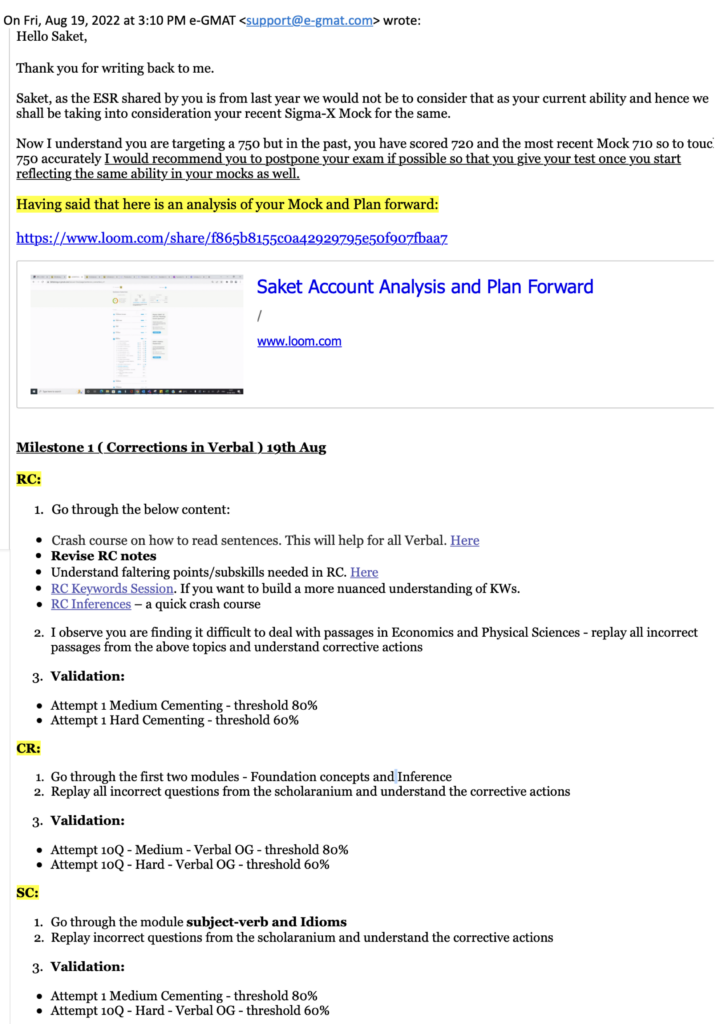
With LMP, I had a very structured approach, which also helped me improve my timing leading to the improvement from 720 to 750.
Abha: When you were at 710-720, you still had some loopholes that caused accuracy or timing issues. In the last ten days of the LMP program, we could identify those issues and work on them with a focused approach. Do you agree?
Saket: Yes, I followed the detailed plan with only 10-15 questions. I’d analyze them and then go for attempting official questions. With Scholaranium questions, I gained the aptitude, skills, and time quotient and then applied them to the official questions. That was an excellent approach. When I think about it in hindsight, it also boosted my confidence.
Abha: Mocks play a critical role in the GMAT preparation journey as it exposes you to a similar test environment. How many official mocks and SIGma-X Mocks did you take before your exam date?
Saket: I took two official mocks and 2 SIGma-X Mocks. My scores were consistent. I felt e-GMAT mocks were very similar to the OG mocks, especially for the verbal. There was not much difference in my scores in both the mocks.
I felt e-GMAT mocks were very similar to the OG mocks
Mocks play an essential role. It’s one thing to solve questions in isolation within two minutes and another to do under time pressure when you can see the clock ticking. And then the panic is also evident. I used to face that in my mocks. The more mocks you solve, the better you get at it. E.g., if you take more time in RC or CR, you can try to make up for it in SC, provided your SC concepts are solid. I realised this after analyzing my mocks.
Abha: What was your sectional(Quant/verbal) sequence? Did you keep the same sequence for mocks as you did in your final GMAT?
Saket: Yes, verbal was a challenge for me, and hence I’d start with it when my mind was fresh, then I’d do quant followed by analytical skill. I had the same sequence for all my mocks and my GMAT test.
Abha: Because you were weaker in verbal, you wanted to tackle that first.
Saket: Exactly. I think verbal was a challenging section for me. I’d warm up with two questions for SC, CR, and RC before my mocks. I replicated the same on the GMAT exam day as well.
Journey from GMAT 710 to 750
Abha: You’ve been preparing by yourself for some time and then with e-GMAT. What is that one learning that made a difference for you this time?
Saket: From 710 to 750, the journey gets more challenging, with every 10 points closer towards the target.
Going from 700 to 720 is definitely hard but progressing from there towards 750 gets exponentially harder. You cannot afford to miss even one question, as that one question can cause the difference between 740 and 750.
I’d try to get all the medium, and easy questions correct and to hit the accuracy of 60% on scholaranium for the hard test, which is also the benchmark set to accomplish the goal. Sticking to the benchmark throughout my preparation journey was the one key thing for me. Being consistent is another essential factor. I’d get overwhelmed some days, but I knew I had to do it. If you drop it and lose the consistency, it’s challenging to get into the zone again.
Abha: We at e-GMAT also emphasize maintaining consistency as having gaps requires you to revisit the concept files, which takes extra time and effort.
So while preparing for GMAT, how many hours were you putting into it? Did you take a break to prepare, or were you working full time??
Saket: I was working full time. On weekdays, I’d give one and a half to two hours, and on weekends I’d study for 3-4 hours. Most of the time, it used to be two hours of solving questions and two hours of error analysis. I want to emphasize that error analysis is a big part of the preparations, and people should not miss that.
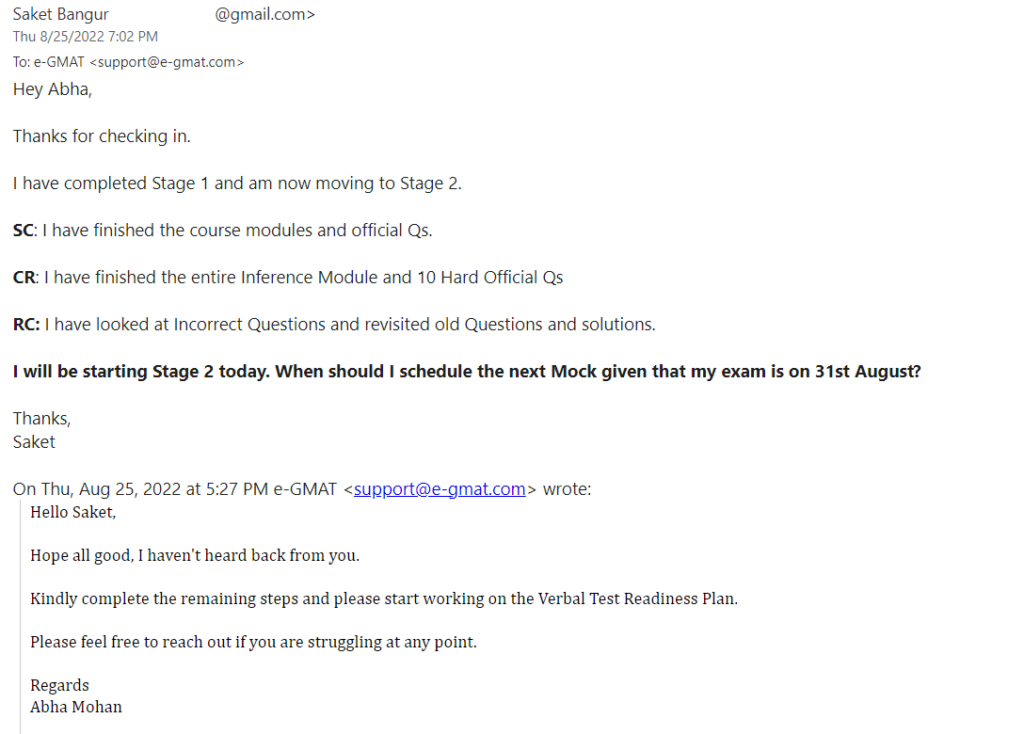
GMAT 750 test day plan
Abha: In your recent attempt, you scored 750. How did you approach the test that day? Did you have any particular set of questions or techniques to solve questions that worked out for you? How was your sub-sectional sequence for verbal?
Saket: I knew the initial questions would be easy. I could do them quickly, 1 minute 40-45 seconds, and allocate more time to the RC and the CR questions. By the 7-8th question, it started to get tough and needed more time to be allocated. But in a way, it’s a good thing as it meant I was doing well. At one point, I realized I was giving 2 minutes to a few SC questions, but I think those questions deserved those two minutes. Starting from CR, I followed the pre-thinking approach quite a bit. First, I’d read the question stem, whether it’s strengthening or weakening or assumption. Based on that, I’d pre-think what the author was saying, Then I’d read the passage and draw the conclusion. I’d have a clear idea about the correct answer even before looking at the answer choices. That was a very effective strategy.
I’d pre-think what the author was saying, Then I’d read the passage and draw the conclusion. I’d have a clear idea about the correct answer even before looking at the answer choices. That was a very effective strategy.
Abha: What about the quant?
Saket: With my experience at mocks, I was decently familiar with the quant. I was mainly focusing on the official questions. I had a fair idea about the type and level of questions I should expect. I was more focused on the Data Sufficiency questions as those were mostly the tricky ones. In the Problem Solving questions, you can guess sometimes, but you have to be involved in solving DS questions. You cannot lapse, and guesswork does not help there at all.
There were also time markers. For verbal, 55 minutes 6 questions, 44 minutes 12 questions. I had allocated 11 minutes for every six questions. In quant, I divided the sets of 10 questions each.

Abha: How much were you able to stick to these time markers? Because as the difficulty level increases, the time required to solve also changes. Were you flexible to accommodate that?
Saket: Yes, I did. Given that the first six questions took me 8-9 minutes instead of 11 minutes, but towards the middle and the end, I was taking more time. My approach was to get as many questions of the first 15 questions, which sets your level. If someone wants to use guesswork when they don’t have time left, I think it’s safer to do it with the middle questions between 20 to 25 than in the end or beginning.
Saket’s secret to success
Abha: You mentioned how you maintained consistency irrespective of your state of mind. You kept going throughout the preparation, and you scored a 750. Apart from consistency, what is the key mantra you’d give other GMAT aspirants?
Saket: I’d highly recommend maintaining an error log. Use that in identifying your weakness, take our questions from the e-GMAT and then apply that same strategy with the OG questions, which will help you strengthen your mind.
The e-GMAT’s cementing quizzes helped me a lot. It had about 18 questions across all subsections, and when you solved them in the given time frame, it gave a clear idea about the percentile-wise performance in each sub-section. According to that, you can set your sub-section target. I’d set it to the highest accuracy for SC, followed by CR, then RC. And when I looked at my ESR, that’s how it had worked.
Abha: You used the platform for verbal, and given your strategy, you could identify your weak areas and go back to those modules. You even maintained the error log.
Saket: Error log, consistency, meaning-based approach, all of it helped me a lot. Towards the end, I even had to guess one or two questions. If you’re spending more than one and a half minutes, you should be okay moving on to the next question by guessing the answers. It’s about the verbal ability, not the sectional ability. Getting one question right at the cost of a few others is not advisable.
Abha: That’s the correct approach. You started following this from the mock stage itself.
Saket: e-GMAT has takt time, the amount of time after which, if you do not see a path forward, you should move on. It was one minute and 20 secs for me in SC. Instead of wasting time, I’d save it and do a CR question to score.
Abha: Yes, it’s a risk call one has to take to move on. Thank you, Saket, for giving us your time. I am sure our audience must have found a lot to learn from your experience.


